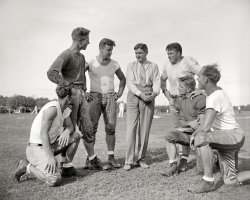
MAY CONTAIN NUTS

Search Shorpy
SHORPY ART

Framed or unframed, desk size to sofa size, printed by us in Arizona and Alabama since 2007. Explore now.
Join and Share
Ad-Free Shorpy
Shorpy is funded by you. Patreon contributors get an ad-free experience.
Learn more.

Recent comments
- A Beautiful Moment
- Such joy
- Bethune-Cookman University today...
- Yellow sky at morning
- Side Winder
- Air Quality?
- Sojourner Truth riot
- None were so blind(ed)
- The less famous sister
- Good ol' days?
- Rise and Fall
- Goo Goo Ga Joob
- Ticket Retention
- Not the only one
- Vagaries of War
- Killed by Amtrak
- Back to the Future
- Wanted --
- If you can't stand the light
- Centralized Traffic Control, I believe
- What's really happening
- Heckuva remote control!
- Sometimes — Things Go Bump!
- I SEE THE LIGHT
- Union Switch and Signal Company
- Get That Light Out Of My Eyes
- Eggs. Eggs. Eggs. The Egg Man is Here!
- Foreboding caption
- Famous Hollywood faces
- Not just S&P
Member Photos
The Shorpy
Print Emporium
Print Emporium
Search Shorpy
Search results -- 30 results per page
- Fort McAllister: 1865
- 1865. "Savannah, Georgia (vicinity). Interior of Fort McAllister." Wet-plate glass negative, left half of stereo ... Posted by Dave - 08/15/2011 - 8:25pm -
![Fort McAllister: 1865 1865. "Savannah, Georgia (vicinity). Interior of Fort McAllister." Wet-plate glass negative, left half of stereo pair, by Sam A. Cooley. View full size.
I love all the photographson this site, but the ones from the Civil War era never fail to blow me away.
Wheel barrelsLooks like the wheel barrels took a direct hit (wheels came off).
[Back then, they were called "wheelbarrows." - Dave]
(The Gallery, Civil War, Sam Cooley, Savannah)](https://www.shorpy.com/files/images/03219u.thumbnail.jpg)
- Let's Build a Bomber: 1942
- ... in Seattle complete assembly and fitting operations on the interior of a fuselage section for a new B-17F (Flying Fortress) bomber. About ... Posted by Dave - 04/27/2014 - 10:02am -
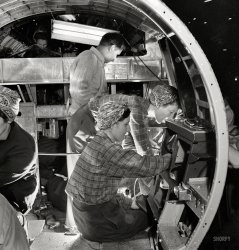
- A More Perfect Union: 1908
- ... damage to many of the finer architectural features of the interior. When that failed the building was abandoned. By the early eighties it ... Posted by Dave - 07/27/2016 - 12:30pm -
![A More Perfect Union: 1908 Circa 1908. "New Pennsylvania [Union] Station, Washington, D.C." 8x10 inch dry plate glass negative, Detroit Publishing Company. View full size.
So many travel choicesGreat photo showing three modes of transportation (besides the train, of course). The old horse drawn cabs on the left of the photo, the new automobile cabs on the far right, and the electric trolley. What a wonderful era for travel.
Lots of timeWe seem to be looking almost due North, across Columbus Circle. Judging from the shadows, it's early morning, probably late Spring or early Summer.
Long layover 'till quarter to four!
Union StationThis photo of D.H. Burnham's magnificent building was probably taken from the north end of the roof of the then-new Senate Office Building (later the Old Senate Office Building, now the Russell Senate Office Building), designed by Carrere and Hastings of New York and built in 1903 to 1908. I spent 10 years in there, working for the Armed Services Committee, on the south (Constitution Avenue) side of the building. The Committee's restored hearing rooms are wonderful examples of American Beaux-Arts at its most lavish.
I Was ThereNot in 1908, but two years ago, and it is still one of the most beautiful buildings I have ever had the privilege to wander in.
Even the façade looks similar to then.
Saved From RuinLooking at it now, it's hard to believe such a grand building came close ruin. The station was converted into a visitors center in the mid-seventies, which caused a lot of damage to many of the finer architectural features of the interior. When that failed the building was abandoned. By the early eighties it was a rat-infested mess with significant damage. The federal government could have easily walked away and let it fall into a state beyond repair. Fortunately, Congress authorized the purchase of the building and ponied up the cash to turn it into what it is today, which is magnificent.
(The Gallery, D.C., DPC, Railroads, Streetcars)](https://www.shorpy.com/files/images/SHORPY-4a23930a.thumbnail.jpg)
- City Point: 1864
- ... shingle are today. And of course the lath and plaster interior wall. It was always being told in history class that so many of the ... Posted by Dave - 07/23/2009 - 10:29am -
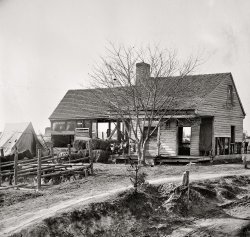
- Christmas Story: 1920
- ... billboard, the light at the top of the water tower, the interior of a train station and a street lamp.
Perfect Setting for ... Posted by Dave - 12/24/2012 - 1:13pm -
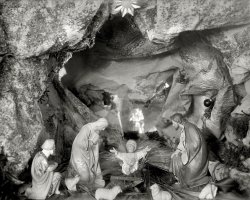
- Man of Steel: 1942
- May 1942. "Denver, Colorado. Interior of a shipbuilding plant, showing workman who previously assembled ... Posted by Dave - 06/24/2015 - 11:48am -
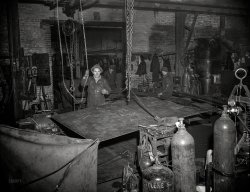
- Crown Restaurant: 1904
- ... then later converted into a movie-theater. The original interior, shown in this old photograph, had 3 balconies. It was demolished in ... Posted by Dave - 12/22/2014 - 11:09am -
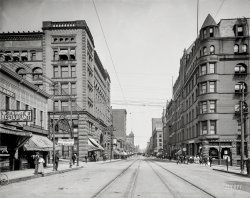
- Deconstructed: 1906
- ... is another photo of the earthquake ravaged building and an interior shot from after the renovations here .
The "Jewelers' ... Posted by Dave - 01/05/2017 - 2:31pm -
![Deconstructed: 1906 "Looking up Post Street from Kearney." Aftermath of the April 18, 1906, San Francisco earthquake and fire. 8x10 inch glass negative. View full size.
Fire Fighting Equipment?On the right side, it looks to me like a burned out piece of fire fighting equipment, maybe a towed pump on wheels?
It's Kearny Street, not Kearney StreetVery common mistake.
Shreve Building still standsInteresting piece here from the sfgate.com site - Shreve & Co., a high-end jeweler, just moved out in 2015, to be replacd by Harry Winston, another high-end jeweler. Shreve & Co. (now just down the block at 150 Post St.) moved into their namesake building in March of 1906 - yes, a month before the earthquake.
Missing windowsWhy did the windows fall out?
[The buildings were gutted by the fire; windows had wooden frames and burned. -tterrace]
Horse-Drawn Steam Fire-EngineA week after the conflagration, when people began to return to San Francisco, Los Angeles Times reporter Harry C. Carr—mistaking Post Street for California Street, and using dumb as a synonym for mute—wrote in the April 26 issue:
In the June 2, 1906 edition of Fire and Water Engineering, A. J. Coffee (a fire appliance manufacturer in Oakland) observed that the San Francisco Fire Department had 56 steamers, nine hook and ladder trucks, nine chemical engines, one combination chemical and hose wagon, four turret-batteries, some 120,000 feet of hose, and a force of 500 "brave and skilled men." He went on to note that:
Approximately 38,000 feet of hose were burned. Engines valued at $13,500 were destroyed (including one that was in the repair shop and could not be hauled out since its wheels had been removed). Old No. 12 engine—Old Betsy—in use in the department for 30 years, was burned on the corner of Post and Kearny streets, where she was abandoned since she had no horses. Her remains stand there now among the ruins and tell the story more vividly than words can portray of the utter helplessness of the San Francisco firemen in this terrible calamity.
Too much praise cannot be given the fire department of the efficient manner in which it worked at the off-set, when the fire alarm service was immediately destroyed. The men went out bravely to fight a dozen or more fires, all of which took the proportions of conflagrations almost immediately, and the firemen succeeded in extinguishing several bad fires that were not in the burned district. After their work was finished at these fires, the firemen took up their hose and apparatus and went to work on large fires in the different parts of the city. They did splendid work, until the city water supply gave out, and there is no doubt that, if water had been plentiful, there would be a different story to tell of San Francisco today.
According to the San Francisco Municipal Reports for the Fiscal Year 1905-6, Ending June 30, 1906, the city lost only three engines, and one— a 1872 Amoskeag Steam Fire Engine, 2d size, No. 390, assigned to Relief Company No. 3—was about the right age (34 years old) as the one A. J. Coffee mentioned (30 years in service).
The boiler banding, the gauge mounting, and some other clues suggest that wreck in the main photo may be a Amoskeag engine:
This image, dated April 20, 1906 and taken from a stereo view card, was titled A fire engine caught and crushed by a falling wall, Post St., San Francisco Disaster, U. S. A.
The spring like thing draped on the wheel is the wire reinforcement that was left after the rubber suction hose (seen in the drawing above) burned away.
This last photo shows recovery efforts with much of the rubble cleaned away and non-salvageable items removed from the remains of the engine:
Jewelers' BuildingNot only did Shreve & Company occupy the building in the background, the building in the foreground, which remarkably still exists, is the firm's new home at 150 Post Street. Even more interesting is that old publications, such as "The Jewelers' Circular" from November 30, 1921, indicate that the 150 Post Street address used to be called the "Jewelers' Building." The Crocker and Langley San Francisco City Directories (SFCD) also confirm this coincidence, and they show numerous professionals in the jewelry making and allied trades as tenants. The 1908 Crocker and Langley SFCD entry for Shreve indicates that they were not able to reopen in their new building until March of 1909 (see below).
There is another photo of the earthquake ravaged building and an interior shot from after the renovations here.
The "Jewelers' Building" apparently had another name before the earthquake, but I cannot read the wording on the sign above the door. See the photo below to have a closer look.
(The Gallery, DPC, Fires, Floods etc., San Francisco)](https://www.shorpy.com/files/images/SHORPY-4a13251a.thumbnail.jpg)
- Ship-Shapers: 1905
- ... South Chicago circa 1905. "Steamer William E. Corey , interior of hold." An inside look at the bulk freighter seen earlier here . ... Posted by Dave - 09/27/2013 - 9:33am -
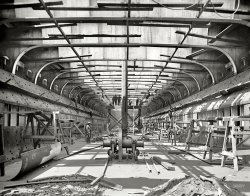
- Suppertime: 1939
- ... is a really pretty dress, compared to the threadbare cabin interior.
[Like a lot of the ladies in these photos, she might have ... Posted by Dave - 05/02/2018 - 4:27pm -
![Suppertime: 1939 February 1939. "Corpus Christi, Texas. Wife of war veteran living in shantytown on Nueces Bay." The lady last seen here. Medium format acetate negative by Russell Lee for the Farm Security Administration. View full size.
Taking it all for grantedThe next time I start complaining about something, I'll try to remember this family.
CriminyWhat an awful and complete mess and what a horrible way to live. These folks would probably be considered "homeless" today and even have less than this hovel to live in.
ClothingShe's got a good dress for such an occasion.
Neatness countsFlour everywhere except on her dress and hands.
Overdressed?That is a really pretty dress, compared to the threadbare cabin interior.
[Like a lot of the ladies in these photos, she might have donned her Sunday best for Mr. Government Photographer, as well as for you and me. - Dave]
(The Gallery, Kitchens etc., Russell Lee)](https://www.shorpy.com/files/images/SHORPY-8b20965a.thumbnail.jpg)
- The Old Neighborhood: 1904
- ... of the end pavilions.
The interior, stark and simpler than most, is characterized by shallow arches, a ... Posted by Dave - 12/24/2017 - 3:59pm -
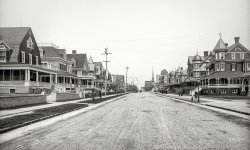
- 1973 Pontiac Grand Am
- ... was a 1973 Grand Am 4 dr in Admiralty Blue with a black interior. 400 V-8, 2 bbl, automatic transmission. But it was regarded as cool ... Posted by gnfd143 - 01/04/2013 - 7:47pm -
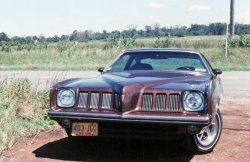
- Standard Upholstery: 1926
- ... up.
Furniture reupholstered and repaired. Draperies and Interior Decorating.
Sufficient unto the day Is the stuffing thereof. ... Posted by Dave - 06/13/2014 - 8:22pm -
![Standard Upholstery: 1926 Washington, D.C. "Industrial exposition, 1926. Standard Upholstery Co." National Photo Company Collection glass negative. View full size.
AsisReminds me of second-hand stores of the 1950s. I can almost smell the mildew - wait, maybe that's coming from the negative.
Dome Fuel truck IDWhite
Furniture of a Better Kind
Washington Post, February 25, 1926.
Exposition to Show Big Range of Products
Washington-made products, ranging from candy to motor trucks, will be on exhibition at the second annual industrial exposition of the Washington Chamber of Commerce, to be held in the Washington Auditorium, March 4 to 13.
“The exposition is planned to give Washingtonians further reasons for civic pride,” Martin A Leese, president, said yesterday. “It should surprise any resident of this community who visits the exposition to see the number of food products, household appliances, wearing apparel and office fixtures which are made in this city.”
Washington Post, January 21, 1924.
Standard Upholstery Store
2810-12 14th St.
“Furniture of a Better Kind”
Overstuffed Furniture, Made to Order, 3-Piece Suite $125 up.
Furniture reupholstered and repaired. Draperies and Interior Decorating.
Sufficient unto the dayIs the stuffing thereof. Who, exactly, determines that furniture is over stuffed, as opposed to "sufficiently stuffed" or even "scantily stuffed?" Probably once a term of art in the upholstery trade, appropriated for vulgar use much in the way that the rubrics "stainless steel appliances," "granite countertops," and "open concept" have become indispensable narrative terms without which no home improvement TV show can long survive.
[The term "overstuffed" simply refers to furniture in which the frame is completely covered with padding and fabric, as opposed to, for example, an armchair with upholstered seat and back, but with wooden arms and/or legs. -tterrace]
And now I know!
Decorating trendI have never seen that style of upholstering before, with the tops of the cushions a lively print and the rest of the couch solid velvet. It looks untidy now, but it may have been more practical in the days before sturdy synthetic fibers to have the sitting surface made from a more durable fabric than velvet.
(The Gallery, D.C., Natl Photo)](https://www.shorpy.com/files/images/SHORPY-32284u.thumbnail.jpg)
- Bacchus Dance: 1909
- ... whose father was one of the founders of the famous interior decoration firm of Herter Brothers.
Five Grecian Urns Am I the ... Posted by Dave - 10/07/2013 - 10:58am -
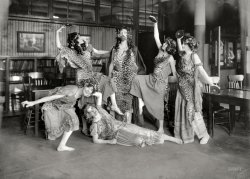
- Carrel of the Belles: 1953
- ... 24, 1953. "Towson, Maryland. Goucher College, Library interior III. Moore & Hutchins, client." Acetate negative by ... Posted by Dave - 05/22/2016 - 8:53pm -
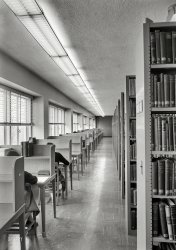
- In for Overhaul: 1942
- ... was required to be drained, cleanout plugs removed and the interior of the boiler washed out with high pressure water jets. Certain ... Posted by Dave - 08/20/2014 - 10:17am -
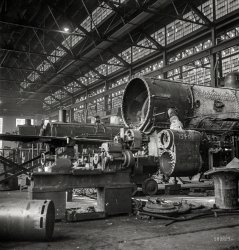
- River Traffic: 1898
- ... was pretty new at the time. From a 1960s report for the Interior Department, addressing both:
... Posted by Dave - 01/23/2019 - 12:09pm -
![River Traffic: 1898 The Mississippi River circa 1898. "Winona, Minnesota. The levee below the bridge." At left, the sternwheeler Lafayette Lamb. 8x10 inch dry plate glass negative, Detroit Photgraphic Company. View full size.
Answered my own questionThe Winona Bridge had a swing span
“The bridge was built from the Wisconsin shore across the back channel to Island 72, now known as Latsch Island, across the main channel to the Winona shore. In the middle of the channel, a huge stone pylon was built up from the riverbed, and a steel and wood beam span was built on top of it. This section of bridge was designed to pivot on that center support, swinging parallel to the shore to allow steamboats, barges and log rafts to pass unimpeded. A tender's shack stood at the pivot point to shelter the rail roadman, who set the machinery in motion to swing the bridge closed when a train approached. At 363 feet, its swinging span -- the "draw" -- was the longest in the world.”
https://www.winonadailynews.com/special-section/pieces-of-the-past/thurs...
Bridge Over Troubled WaterTwo bridges can be seen in this photo. One had been around for more than 25 years. The other, much bigger, was pretty new at the time. From a 1960s report for the Interior Department, addressing both:
Although a railroad bridge connected Winona to the Wisconsin shore as early as 1871, the city had no direct highway access for another two decades. Teamsters made do with a ferry that carried them over the Main Channel to Latsch Island; there they disembarked onto a long wooden trestle that spanned the North Channel and the river's remaining expanse. In 1892, the ferry finally gave way to Bridge #5930, Steel, cantilever, through-truss design, the span was a municipally financed project designed to make Winona the main trade center for its Wisconsin neighbors. To retire the construction debt, the city administered the new "High Wagon Bridge" as a toll crossing.
By the 1930s, auto traffic was making the now "old" high bridge obsolete, with its zigzag connection to an older North Channel wagon bridge a serious impediment.
A new span was designed and survives today about a quarter mile up river from the bridges seen in the photo above. Ironically, an updated form of the original North Channel wagon bridge survives for non-motorized traffic.
Full stop?Why do you suppose they put a period after "Lamb"?
[Period signage. - Dave]
Period signage. Nice.I think Dave would be absolutely miserable if confined to a language where all words have only one meaning.
Clouds? Sky?Just realized that the sky has clouds. Was this shot with panchromatic film?
[This wasn't shot with any kind of film. It's a glass plate negative. - Dave]
(The Gallery, Boats & Bridges, DPC, Railroads)](https://www.shorpy.com/files/images/SHORPY-4a04017a1.thumbnail.jpg)
- All the Allens: 1937
- ... in cut-over areas. Dilapidated log cabins and shacks; interior details. Poor families; Bohemian farm families. Few scenes in town. ... Posted by Dave - 12/29/2014 - 12:41pm -
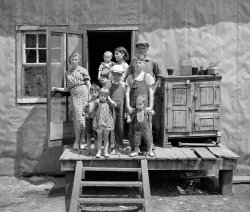
- Bond Building: 1907
- ... the windows are most likely anchored to the unfinished interior.
(The Gallery, D.C., Natl Photo) ... Posted by Dave - 06/02/2019 - 12:55pm -
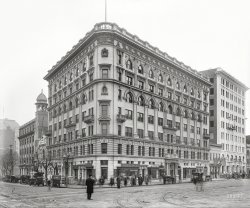
- Silver Place: 1939
- ... was reduced last month to $175,000. Lovely photos of the interior here:
... Posted by Dave - 04/08/2019 - 9:19pm -
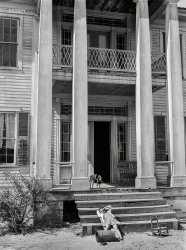
- Pair of Sixes: 1919
- Washington, D.C., 1919. "Snelling Motor Co., interior." Two used American Sixes. National Photo Company Collection glass ... Posted by Dave - 09/14/2011 - 12:00am -
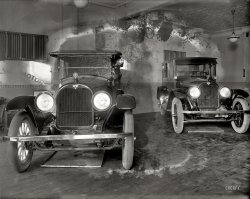
- Star Drug: 1946
- ... "Star Drug, business on Kingsbridge Road, Bronx, New York. Interior to rear. Jose A. Fernandez, client." Jergens Lotion, just 79 cents a ... Posted by Dave - 06/25/2015 - 11:51am -
![Star Drug: 1946 Jan. 16, 1946. "Star Drug, business on Kingsbridge Road, Bronx, New York. Interior to rear. Jose A. Fernandez, client." Jergens Lotion, just 79 cents a (glass) bottle. Large-format acetate negative by Gottscho-Schleisner. View full size.
What's in those drawersThose drawers behind the counter near the cash register held the condoms. Don't ask how I know -- I just do.
Different times.
Back wallThose bottles on the back wall suggest "potions" more than "drugs".
Thank you Margaret SangerCompletely hidden and never mentioned was standard practice in making rubber goods (condoms) or womb supporters (diaphragms) available, as it was illegal to distribute any form of contraceptive until 1965 when the Supreme Court struck down the Comstock Law of 1873.
[It was illegal in Connecticut, not New York. - Dave]
Check Out"Check Out" the size of that cash register on the right.
(The Gallery, Gottscho-Schleisner, NYC, Stores & Markets)](https://www.shorpy.com/files/images/SHORPY-5a12513u1.thumbnail.jpg)
- Arcade Pants Parlors: 1900
- ... Ohio, circa 1900. "The Arcade Building, Superior Avenue." (Interior view here .) Ground-floor tenants include the Hat Box, Arcade Pants ... Posted by Dave - 02/03/2017 - 9:28am -
![Arcade Pants Parlors: 1900 Cleveland, Ohio, circa 1900. "The Arcade Building, Superior Avenue." (Interior view here.) Ground-floor tenants include the Hat Box, Arcade Pants Parlors and, next door, a Misfit Clothing Parlor (a.k.a. Fitwell Clothing) and Chisholm's Boot Shop. 8x10 inch glass negative, Detroit Publishing Co. View full size.
Cleveland's Cable CarsIf you look closely you can see there are streetcar trolley wires erected over cable car tracks. By 1890 electric streetcars were becoming the standard for urban transit, but in Cleveland in that year cable car service started on two streets: Superior and Payne. The cable service lasted only ten years, and electric streetcars started running on Superior at the time of this photograph. There is more information about Cleveland's cable cars and transit history here.
Wut?"Fitwell Clothing" on the sign and "Misfit Clothing" on the awning; any idea what that's about?
[In the clothing trade of the time, "misfit clothing parlor" was a common appellation for a store or portion of a store that sold what we would today call "irregulars." -tterrace]
Thank'ee kindly!
The Arcade Building todayThe Arcade Building is now a Hyatt Regency hotel. Here is a modern glamour photo from Hyatt.
(The Gallery, Cleveland, Stores & Markets)](https://www.shorpy.com/files/images/SHORPY-4a08341a.thumbnail.jpg)
- Binary Banking: 1905
- ... section of this area that clearly shows the location and interior floor plan of the two banks in the structure. Bank Alley to the left ... Posted by Dave - 05/16/2016 - 3:19pm -
![Binary Banking: 1905 Cincinnati circa 1905. "Lafayette and Franklin Banks, Third Street." With a painter and a window-washer in supporting roles. 8x10 glass negative. View full size.
Located at 124 East Third StreetAn old Cincinnati City Directory lists the Franklin Bank at 124 E. Third St. Just about everything on Third Street has been replaced with new modern buildings. Here is an old map section of this area that clearly shows the location and interior floor plan of the two banks in the structure. Bank Alley to the left of the bank appears to have been renamed "Berning (Bank) Alley" on the map and the alley still exists on Google maps today and it is now called Berning Place. Everything shown from Berning Alley to the corner of 3rd and Main is now a parking garage.
Perilous Window Washer & The Banking ChickenBefore anyone complains that there is no window washer, I had to look long and hard to find him. He is death-defyingly way up in the top of the picture.
Also, I'm sure it's not a chicken in the middle of downtown Cincinnati but, that sure looks like one at the bank's door. Perhaps she puts all her eggs in one bank.
[I think the "chicken" is a boot jack. -tterrace]
How fascinatingthat there was a scenery painting studio in the second floor of the bank building, with all that great daylight from the glass dome. TTerrace, I think that the "chicken" is actually a boot scraper, to get mud and horse dookey off before going indoors. A boot jack is to help remove your boot from your foot.
[You're probably right. -tterrace]
(The Gallery, Cincinnati Photos, DPC)](https://www.shorpy.com/files/images/SHORPY-4a11627a.thumbnail.jpg)
- The Old Woman: 1935
- October 1935. "Interior of a home of prospective resettlement client. Brown County, Indiana." ... Posted by Dave - 09/09/2011 - 12:40pm -
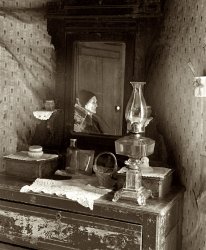
- Washington Masonic Memorial: 1923
- ... write-up about the temple (complete with photos of the interior)on the "Roadside America" website at:
... Posted by Dave - 02/23/2013 - 3:09am -
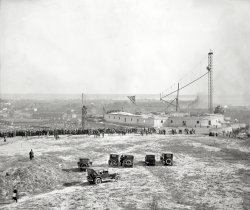
- Catalina Island: 1965
- ... familiar. Just read about one for sale a month ago. Nice interior shots in a couple of links:
... Posted by rsyung - 08/17/2015 - 10:07am -
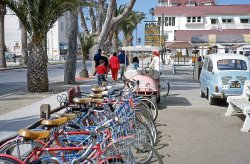
- Near Belle Glade: 1939
- ... Keys built in the 1920s, and they had a clerestory and the interior of the buildings without air conditioning were surprisingly ... Posted by Dave - 04/26/2021 - 5:20pm -
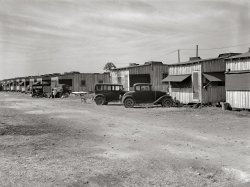
- X-Troop: 1865
- 1865. "Petersburg, Virginia. Interior view of Fort Sedgwick." This scout's Indian name: Sitting Duck. Wet ... Posted by Dave - 06/08/2014 - 3:39pm -
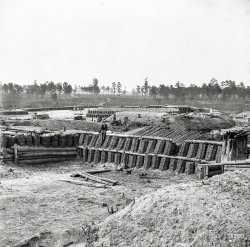
- Team Players: 1937
- ... NFL team to integrate, after having been warned by Sec. of Interior Udall to hire black players or face retribution.
(The Gallery, ... Posted by Dave - 04/10/2013 - 10:02am -
